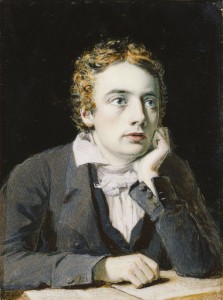Ode to a Nightingale
Jack Ramey reads Ode To a Nightingale.
My heart aches, and a drowsy numbness pains
….My sense, as though of hemlock I had drunk,
Or emptied some dull opiate to the drains
….One minute past, and Lethe-wards had sunk:
‘Tis not through envy of thy happy lot,
….But being too happy in thine happiness, —
……..That thou, light-wingèd Dryad of the trees,
……………..In some melodious plot
….Of beechen green, and shadows numberless,
……..Singest of summer in full-throated ease.
O for a draught of vintage! that hath been
….Cool’d a long age in the deep-delvèd earth,
Tasting of Flora and the country-green,
….Dance, and Provençal song, and sunburnt mirth!
O for a beaker full of the warm South!
….Full of the true, the blushful Hippocrene,
……..With beaded bubbles winking at the brim,
……………..And purple-stainèd mouth;
….That I might drink, and leave the world unseen,
……..And with thee fade away into the forest dim:
Fade far away, dissolve, and quite forget
….What thou among the leaves hast never known,
The weariness, the fever, and the fret
….Here, where men sit and hear each other groan;
Where palsy shakes a few, sad, last grey hairs,
….Where youth grows pale, and spectre-thin, and dies;
……..Where but to think is to be full of sorrow
……………..And leaden-eyed despairs;
….Where beauty cannot keep her lustrous eyes,
……..Or new Love pine at them beyond to-morrow.
Away! away! for I will fly to thee,
….Not charioted by Bacchus and his pards,
But on the viewless wings of Poesy,
….Though the dull brain perplexes and retards:
Already with thee! tender is the night,
….And haply the Queen-Moon is on her throne,
……..Cluster’d around by all her starry Fays
……………..But here there is no light,
….Save what from heaven is with the breezes blown
……..Through verdurous glooms and winding mossy ways.
I cannot see what flowers are at my feet,
….Nor what soft incense hangs upon the boughs,
But, in embalmèd darkness, guess each sweet
….Wherewith the seasonable month endows
The grass, the thicket, and the fruit-tree wild;
….White hawthorn, and the pastoral eglantine;
……..Fast-fading violets cover’d up in leaves;
……………..And mid-May’s eldest child,
….The coming musk-rose, full of dewy wine,
……..The murmurous haunt of flies on summer eves.
Darkling I listen; and, for many a time
….I have been half in love with easeful Death,
Call’d him soft names in many a musèd rhyme,
….To take into the air my quiet breath;
Now more than ever seems it rich to die,
….To cease upon the midnight with no pain,
……..While thou art pouring forth thy soul abroad
……………..In such an ecstasy!
….Still wouldst thou sing, and I have ears in vain—
……..To thy high requiem become a sod.
Thou wast not born for death, immortal Bird!
….No hungry generations tread thee down;
The voice I hear this passing night was heard
.>..In ancient days by emperor and clown:
Perhaps the self-same song that found a path
…..Through the sad heart of Ruth, when, sick for home,
……..She stood in tears amid the alien corn;
……………..The same that ofttimes hath
….Charm’d magic casements, opening on the foam
……..Of perilous seas, in faery lands forlorn.
Forlorn! the very word is like a bell
….To toll me back from thee to my sole self!
Adieu! the fancy cannot cheat so well
….As she is famed to do, deceiving elf.
Adieu! adieu! thy plaintive anthem fades
….Past the near meadows, over the still stream,
……..Up the hill-side; and now ’tis buried deep
……………..In the next valley-glades:
….Was it a vision, or a waking dream?
……..Fled is that music:—do I wake or sleep?
Poem by John Keats (1795–1821)
Painting of John Keats: Listening to the Nightingale by Joseph Severn (1793–1879), via EnglishHistory.net and Wikimedia Commons
Jack Ramey talks about John Keats and reads Ode to a Nightingale.
 John Keats, born on October 31, 1795, is the quintessential Romantic poet. He was not well regarded during his brief lifetime, but now, more than two hundred years after his birth, his small output of poems are considered some of the most beautiful and beloved in the English language. Two years ago, I stood on the very ground, Wentworth Place in Hampstead (now the Keats House Museum), where Keats composed his famous Ode to a Nightingale, one of the most moving poems ever written.
John Keats, born on October 31, 1795, is the quintessential Romantic poet. He was not well regarded during his brief lifetime, but now, more than two hundred years after his birth, his small output of poems are considered some of the most beautiful and beloved in the English language. Two years ago, I stood on the very ground, Wentworth Place in Hampstead (now the Keats House Museum), where Keats composed his famous Ode to a Nightingale, one of the most moving poems ever written.
His good and loyal friend, the artist, Joseph Severn, painted the portrait shown above. When Keats contracted tuberculosis, Severn went with Keats to Rome, nursing him until the end. He died of tuberculosis in Rome at the age of 25 convinced that his work would be forgotten. He requested that no name or date be written on his tombstone, only the inscription: “Here lies One whose Name was writ in Water.”
Painting of John Keats by Joseph Severn (1793–1879), via Wikimedia Commons
Related Poem: Ode on a Grecian Urn
